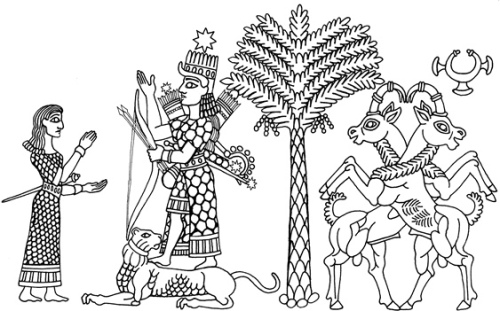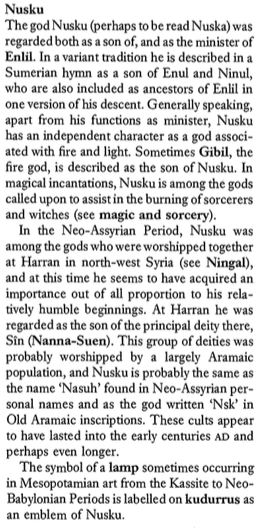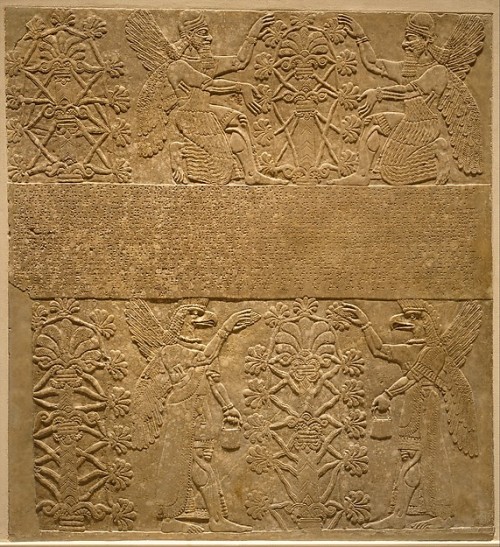“As we have seen, the fragments B and D then continue the story in different ways, although there is one common trait before they diverge: in both places Adapa is offered, and accepts “garment and oil” (Amarna fragment B rev. 60-5; Nineveh fragment D rev. 1-3).
We think Izre’el is right here pointing out that there is a difference between the “food and water” that Ea denied Adapa, and the “garment and oil” that he allowed Adapa in his instruction before Adapa went to heaven.

A bas relief in the Louvre.
In this case the bird-apkallū tends to a sacred tree. Considering the mullilu in his right hand and the banduddu in his left, (tree cone and water bucket), he is engaged in a water ritual intended to sanctify the sacred tree. This is a common motif in Sumerian and Neo-Assyrian idols.
This bas relief is in the Louvre.
Primary publication Nimrud NW Palace I-24 = RIMA 2.0.101.023, ex. 189 (f)
Collection Nimrud, Iraq (a); British Museum, London, UK (b); Louvre Museum, Paris, France (c); Nimrud, Iraq (d); Detroit Institute of Arts, Detroit, Michigan, USA (e); British Museum, London, UK; Louvre Museum, Paris, France
Museum no. Nimrud fragment no. 42 (a); BM 098061 (b); AO 22198 (c); Nimrud fragment no. 43 and 45 (d); DIA 47.181 (e) (photo: DIA); AO 19849
Accession no. 1903-10-10, 0002 (b)
Provenience Kalhu (mod. Nimrud)
Period Neo-Assyrian (ca. 911-612 BC)
“Food and water” symbolize eternal life, while “garment and oil” symbolize wisdom.
(Izre’el refers here to clothes as the distinctive marker of human civilization, as seen for instance in the myth about the creation of Enkidu, Schlomo Izre’el, Adapa and the South Wind: Language Has the Power of Life and Death, Eisenbrauns, 2001, pp. 122-3.)
Thus, according to both versions, the wisdom Adapa already has is confirmed in heaven. Then Adapa, according to fragment B, returns to the earth and his wisdom is confirmed, but he has lost the possibility for eternal life.
Fragment D continues:
Adapa, from the foundation of heaven to the summit of heaven,
looked at it all and saw his (Anu’s) awesomeness.
At that time Anu estab[lished] Adapa as watcher.
He established his freedom from Ea.
[An]u se[t] a decree to make glorious his lordship forever:
[ … ] Adapa, seed of humankind,
[ … ] he broke the South Wind’s wing triumphantly,
(and) ascended to heaven, —so be it forever!
(Nineveh fragment D rev. 7-14).
The scene is a scene of inauguration. Immediately before, as we have seen, Adapa is given a new garment and is anointed. In light of what comes next, this is in D not only a confirmation of the wisdom Adapa already has; it is the preparation for introducing Adapa to the highest office any human was given.
Adapa, belonging to primeval time, and being the chosen one of Ea, already had a wisdom that superseded ordinary human wisdom, according to Fragment A. His broad understanding did, however, not include insight in the heavenly domain.
In our text Adapa is first equipped with the proper attire for the inauguration and then comes a description of the new insight he is given. Now his eyes are opened to the whole spectrum of divine understanding. If he previously only had insight into earthly matters, he now got what he was missing, full insight into the whole of Anu’s domain: “Adapa, from the foundation of heaven to the summit of heaven, looked at it all and saw his (Anu’s) awesomeness.”
Against the background of this new perception of the whole coherence, the proclamation of Adapa’s new status is given. He is inaugurated into massartu, “the office of being a watcher.” The expression has two contexts. On the one hand it refers to the cosmic order, which he now has received full insight into; on the other hand it refers to his magical competence, which is clear from the references dealing with illness that follow the inauguration.

Ishtar receives the worship of an Amazon. Ishtar stands on a lion, holding a bow with arrows at her back. Her eight-pointed star is atop her head.
Lusty antelopes rear on the right side, perhaps signifying the god Ea.
The portrayal of the tree is somewhat problematic, as it differs from the iconic depictions of the sacred tree common in Neo-Assyrian art.
There is no contradiction between these two competences; the one who has insight into the hidden divine realm is also the one who is capable of fighting the evil demons causing misery on earth.
The sentence, “[An]u se[t] a decree to make glorious his lordship forever,” can be interpreted in two ways. The bēlūssu, “his lordship,” can refer to Anu; through this act Anu establishes his lordship. This seems a bit odd, since nowhere in the myth is Anu’s lordship challenged. It seems more likely that the pronoun refers to Adapa. The lordship refers to Adapa’s role as watcher, since he broke the South Wind’s wing so triumphantly.
This is the version of the myth lying behind the first apkallu in Bīt Mēseri. The name of this apkallu is U-an, “the light of An.” This is simply a naming according to what takes place in the inauguration.
He was the one who could complete “the plans of heaven and earth,” because he was the heavenly watcher who had seen everything, from the foundation to the summit of heaven. On the other hand, the seven apkallus occur in a special setting in Bīt Mēseri; the apkallus were invoked to protect human beings from diseases caused by demons.
In a similar context, the incantation series “to block the foot of evil into a man’s house” (cf. below), the apkallus are repeatedly called massarū; they are the watchers of health and life. As already stated, there is no contradiction here, because the insight in the divine real is the precondition for fighting demons.
Thus we have reached the conclusion that the different versions of the Adapa Myth are reflected in two ways in Bīt Mēseri. The apkallu who went up to and down from heaven is the Adapa from fragment B; the apkallu who had the name “Light of An” was the Adapa from fragment D. This explains the curious twin roles between the first and seventh apkallu. It also explains the double name Uandapa, simply expressing this is the first Adapa, named Uan.
And it is to be noted that even though we must assume that this quibbling with versions, roles, and names was Assyrian, it is through the name Uan that the first apkallu is known both in Berossos and in the Uruk list in the Babylonian environment.”
Helge Kvanvig, Primeval History: Babylonian, Biblical, and Enochic: An Intertextual Reading, Brill, 2011, pp. 126-9.






